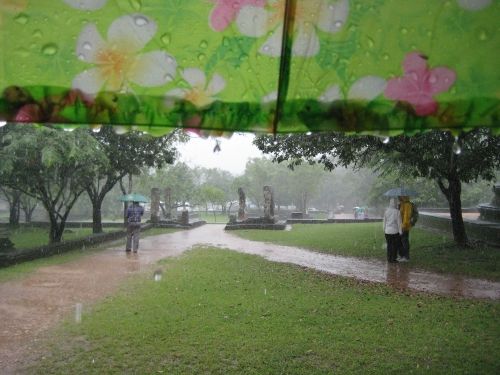
In Polonnaruwa hatte die Regenzeit vergessen, dass sie vorbei war. Zum Glück hatten wir uns am Morgen gegen Fahrräder und für die Ganztagesanmietung eines Tuk-Tuk entschieden. Ja, es sah ein bisschen nach Regen aus, aber was da runterkam waren wolkenbruchartige Regenfälle, die Temepelanlagen zu Wasserstraßen machten. Bei manchen Pfützen konnte man nicht sicher sein, dass sie nicht doch mind. knöcheltief waren und hier und da wurde eine Treppe zum Wasserfall. Und das in Birkenstocks… Nichtsdestotrotz haben wir standhaft die Ruinen von Polonnaruwa besichtigt, die auch gerne als Hintergrund für Hochzeitsfotos genutzt werden.
In Polonnaruwa the rainy season had forgotten that it had already stopped. Luckily, we had decided against rental bikes in the morning and rented a tuk-tuk for the day instead. Yes, it was a little cloudy maybe but what we encountered were torrential rains that turned temple compounds into waterways. With some puddles you couldn’t be sure they weren’t ankle deep after all and some stairs became waterfalls with water gushing down. Try to navigate that in Birkenstocks… But all this didn’t deter us and we saw the ruins of Polonnaruwa which are also a popular spot to have wedding pictures taken.
Gut 200 Jahre (1017-1235) war Polonnaruwa Hauptstadt, aber auch seit dem 2. Jahrhundert schon von strategischer Bedeutung. Die ausgedehnten historischen Anlagen werden im Reiseführer als „Naturidyll zwischen Ruinenmauern“ beschrieben. Tiere waren genügend unterwegs (wenn auch keine Elefanten) und man hörte ein ständiges Zirpen und Zwitschern von Vögeln, wenn es nicht vom Regen übertönt wurde. Teilweise kam ich mir vor wie in einem Indiana Jones Film. Nach dem letzten hier residierenden König wurden die Anlagen komplett überwuchert und erst 1820 durch einen britischen Leutnant „wiedergefunden“.
For more than 200 years (1017 to 1235) Polonnaruwa was the capital but known for its strategic importance in the 2nd century already. My guidebook calls the archeological finds a „nature idyll among ruins“. Quite a few animals were about (though no elephants) and there was a constant chirping and singing from a number of different birds. That is when the rain subsided enough. Sometimes I felt as if I were in an Indiana Jones movie. The city was soon taken over by jungle once the last king left and was rediscovered only in 1820 by a British lieutenant.
Angefangen haben wir unsere Tour im wirklich guten (mit vielen Karten ausgestatteten!) Museum, um dann in den angrenzenden Palastbezirk des Königs Nissankalla Malla zu gehen. Dort wurde u.a. (und vor dem Regen) das obige Foto gemacht, wo ich eben dem Löwenthron in der Königlichen Ratshalle posiere. Von den im Hintergrund zu erkennenden Säulen gibt es 48 Stück, die neben ihrer tragenden Rolle Auskunft über die Positionen der Ratsmitglieder geben.
We started our sightseeing tour at the marvellous museum (which featured many maps!) and then went on to see the adjoining palatial district of king Nissankalla Malla. This is where the picture above was taken (before the rain): I am posing with the lion’s throne in the royal council. There are 48 pillars (some of which you can make out in the back of the picture) which not only held the roof but also bear inscriptions detailing the different positions of the council members.
Insgesamt am eindrucksvollsten war allerdings die Terrasse der Zahnreliquie. Diese 100×110 Meter große Terrasse beherbergt eine Reihe von Bauten, Statuen und sonstigen archäologisch interessanten Funden, wie z.B. den Galpota im Bild oben: ein 25t schweres Steinbuch, das der König Nissankalla Malla in Auftrag gab, um seine Großartigkeit für die Nachwelt festzuhalten – in ausgedehnten 4300 Zeichen. Der Vatadage, das runde Reliquienhaus, ist sehr detailverliebt gestaltet… da hätte man stundenlang Elefanten, Löwen und Gnome fotografieren können:
But the most impressive really was the Terrace of the Tooth Relic. There are a number of buildings, statues and otherwise interesting archeological finds on this terrace measuring 100×110 meters / 300 x 350 feet. There’s the galpota in the picture above: a stone book that weighs 25 tons. It was ordered by King Nissankalla Malla so that all the world should know about his greatness for generations to come… with no less than 4,300 signs. The vatadage, a round „house of relics“ to me is very special due to its love of detail… I could have taken pictures of elephants, lions and trolls for hours on end:
Viel Detail ist auch noch am Thuparama zu erkennen, einem Statuenhaus aus dem 12. Jahrhundert. Zwar sind die noch verbleibenden Statuen alle ziemlich beschädigt, aber der Bau an sich lässt noch die einstige Pracht erahnen – z.B. über die filigranen Tempelreliefs an der Außenmauer.
The Thuparama, a „house of statues“ built in the 12th century, also shows love for detail. Unfortunately, the remaining statues are quite damaged but the building as such still shows some of its former glory – e.g. the intricate temple reliefs on the outer walls.
Zwar ist der Atadage das wichtigste religiöse Gebäude (das „Haus der acht Reliquien“), aber außer den das verschwundene Obergeschoss tragenden reichlich verzierten Säulen ist nicht mehr viel davon übrig. Auch eine Buddha-Statue hat es von den Socken gehauen.
From a religious point of view the atadage (the „house of the eight relics“) is the most important building but not much is left of it: the generously decorated pillars that used to carry the second floor are still there but even one of the buddha statues was swept clear of its feet.
Unsere nördlichste Erkundung waren die berühmten Buddhas von Gal Vihara – und auch wenn sie sehr schön waren und es heißt, dass viele Sri Lanker sie als die eindrucksvollsten der Insel betrachten, so haben mich doch andere Dinge schon mehr beeindruckt.
Our northernmost discovery brought us to the famous buddhas of Gal Vihara – and even though they are beautifully done and it’s said that many people here consider them to be the most impressive on the island, I have to say that other things have impressed me more.
Mittlerweile sind wir nach einer weiteren dreistündigen Busfahrt in Anuradhapura angekommen – ein Wunder. Waren auch die anderen Busfahrer bislang dem Risiko nicht abgeneigt, so schien mir der letzte voll des Wahnsinns. Im strömenden Regen wurde der Scheibenwischer ungefähr einmal alle halbe Stunde betätigt, wahrscheinlich, um das Material zu schonen. Ähnliches vermutete ich auch bei der Nutzung der Bremsen. Da stellte sich jedoch heraus, dass die geschont werden mussten, um die regelmäßige Vollbremsung an vollkommen aus dem Nichts auftauchenden Haltestellen zu kompensieren… Dafür waren sie mit dem an dem über dem Rückspiel angebrachten buddhistisch-hinduistischen Mehrfachschrein gekoppelt, der immer in ein Farbenmeer explodierte, wenn gebremst wurde. Vier zugestiegene Mönche strahlten jedoch die nötige Ruhe aus, uns entspannt in unser Schicksal zu ergeben…
After another 3-hour bus ride we have now reached Anuradhapura – a miracle. None of the bus drivers so far could have been characterized as risk-averse but this one was shrieking mad. In pouring rain the windshield wipers were put to use about once in 30 minutes – probably to reduce wear and tear… I assumed the same about the brakes. But it turned out that they needed to be saved to compensate for the sudden stops at full speed when one of those unexpected bus stops turned up out of the blue… But then the brakes were connected to the hindu-buddhist multi-God shrine above the rearview mirror that exploded in a colorful firework every time the brakes were used. However, four Buddhist monks on board exuded the necessary tranquility to let us lean back and relax…
Barbara

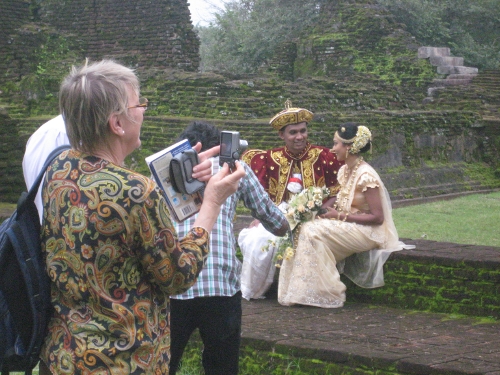
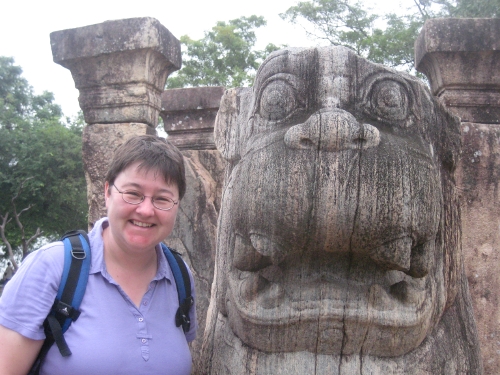
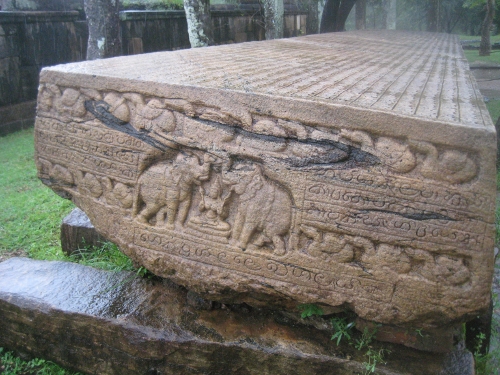
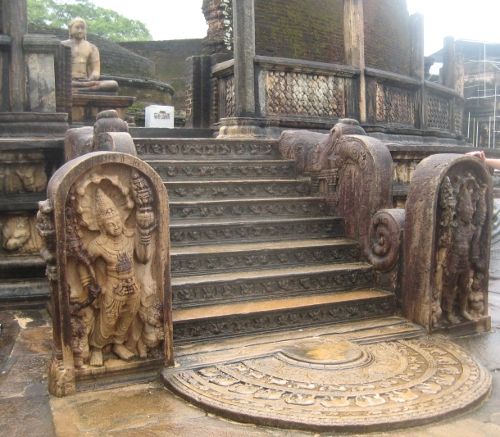
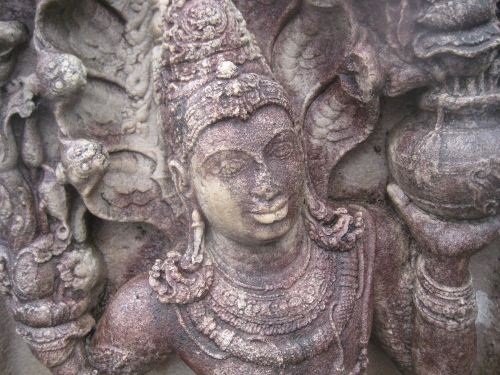
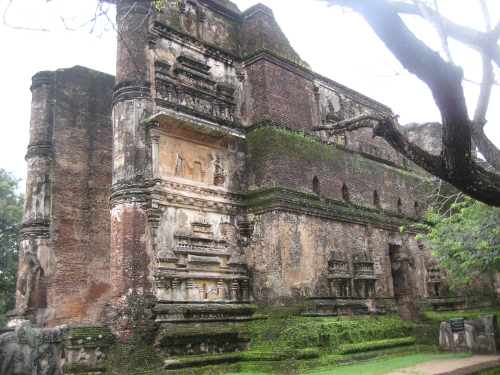
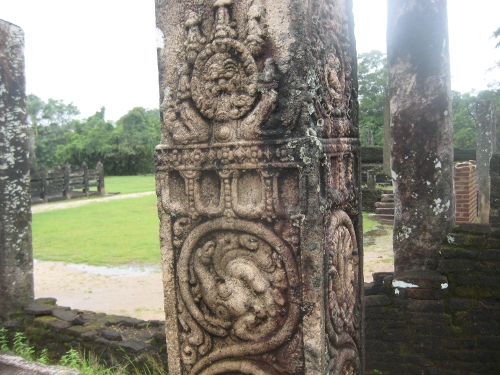
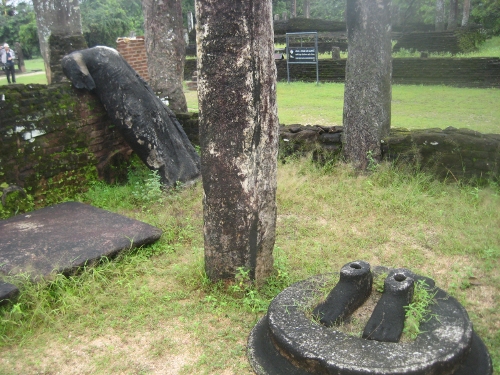
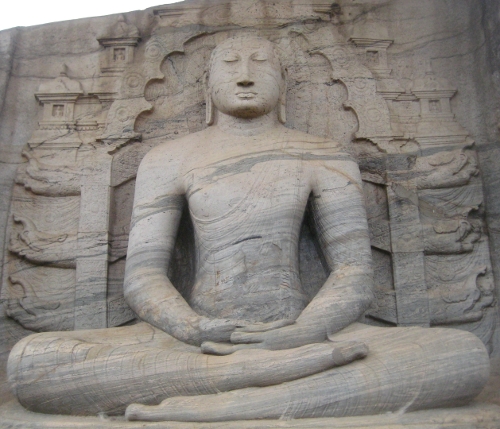
Wow ich wusste ja gar nicht das Sri Lanka so eine Perle ist! Schön dass du uns mit deinen fotos und Text an deinem Urlaub teilnehmen lässt; ich find´s ganz toll und mein Fernweh wird immer größer…. Sehe ich da einen Sonnenbrand in deinem Gesicht? Pass auf dich auf!
LikeLike
Great photos and history lesson … not sure I could relax on that bus though!
LikeLike
Loving the stories and pictures!
Too bad it rained, but then it might have been sweltering!
I’ve been on one of those buses in the Phillipines!
It’s best to talk to your neighbor, and not even look out the windows!
LikeLike